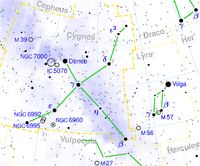Deneb
 From Conservapedia
From Conservapedia | Deneb | |
|---|---|

| |
| Observational Data | |
| Designation | Alpha Cygni HD 197345 HIP 102098 |
| Right ascension | 20h 41m 25.9s |
| Declination | +45o 16' 49" |
| Constellation | Cygnus |
| Type of object | Supergiant |
| Magnitude | Apparent mag: 1.25 Absolute Mag: 6.95 |
| Astrometry | |
| Distance from Earth | ~1400 ly |
| Radial velocity | −4.5 km/s |
| Proper motion | RA: 1.99 mas/yr Dec.: 1.95 mas/yr |
| Parallax | .29 ± 0.32 mas |
Deneb, also called Alpha Cygni, is one of the most familiar stars in the night sky, as well as one of the most distant luminous stars that can be clearly viewed by the unaided eye, with an apparent magnitude of 1.25.[1] A white supergiant star, Deneb is located in the constellation of Cygnus.
History and Cultural significance[edit]
The name of Deneb is derived from the Arabic word for tail, dhaneb, that originated in the phrase Dhanab ad-Dajājah, or "tail of the hen" (Arabic: ذنب الدجاجة). In China, Deneb is referred to as 天津四 (the Fourth Star of the Celestial Ford). The star is featured in the Chinese mythological story of Qi Xi, where Deneb is either the marker for the location of the magpie bridge across the Milky Way, or as the fairy chaperon for the magpie bridge so that the lovers Niu Lang (Altair) and Zhi Nü (Vega) may be reunited for one night a year during the summer. The star is also known by several other names from various cultures, including Deneb Adige, Denebadigege, Denebedigege, Aridf, Al Ridf, Gallina ("the hindmost"), and Os rosae (in German).[2]
The Star[edit]
Deneb is the brightest star of the Cygnus constellation (also known as the Swan) and the 19th brightest star in the night sky overall. The star itself is of spectral class A2 Ia, making it a white supergiant star, with a surface temperature of around 8500K.[3]
The star is estimated to be around 1,550 light years away away as measured by the Hipparcos satellite in 2007,[4] earlier estimates have placed the star as close as 1340 light years and as far as 1840 light years distant.[3] Deneb is estimated to have between 20 and 25 times the sun's mass, showing it to be a low density star which is expected for a supergiant. However, the size of Deneb is estimated to be 108 times that of our star, so that if Deneb was at the center of our Solar System its diameter would extent to half as far as the orbit of the Earth. The most incredible difference is that Deneb is 54,400 times as luminous as our own sun, so luminous that if the star was as close as Vega (25 light years away), it would be 15 times brighter then Venus, the brightest object in the night sky (excluding the Moon).[3]
The star is burning its fuel so intensely it is losing mass at a rate a millionth of a solar mass per year, 40 million times as quickly as our own Sun. Because of this, the star will burn through its very short relative stellar lifetime, first by becoming a red supergiant and finally ending its life supernova in a few million years times.[3]
References[edit]
- ↑ http://www.heavens-above.com/hipentry.asp?hip=102098
- ↑ Richard Hinckley Allen, Star Names: Their Lore and Meaning (1963), p. 195.
- ↑ 3.0 3.1 3.2 3.3 http://www.astro.illinois.edu/~jkaler/sow/deneb.html
- ↑ https://arxiv.org/abs/0804.2553
Categories: [Astronomy]
↧ Download as ZWI file | Last modified: 03/25/2023 17:49:50 | 2 views
☰ Source: https://www.conservapedia.com/Deneb | License: CC BY-SA 3.0
 ZWI signed:
ZWI signed: KSF
KSF